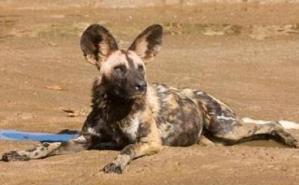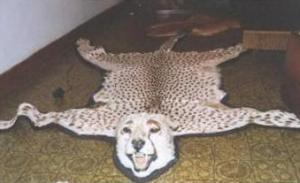Michelle Thorn
The project will provide objective measures of current patterns, influential factors and impacts of human-carnivore conflict in South African farmlands, as a first step toward conflict mitigation.

African wild dog.
Alleviating the increasingly common world-wide phenomenon of human-carnivore conflict is central to carnivore conservation. In South African farmlands jackals, caracals, brown hyaenas, leopards, African wild dogs and cheetahs co-exist with people. Conflict is rife and arises mainly from predation on game or livestock, leading to widespread killing of suspected predators.

Cheetah skin.
32% of South African carnivore species are already classified threatened or near threatened and carnivores are inherently vulnerable to demographic disturbances. Sustained, indiscriminate extermination must therefore exert far reaching adverse effects on local and possibly even regional metapopulations. At the same time, predation can have a serious economic impact on game and livestock farmers, and a wider impact on agricultural production and rural development. The extent and magnitude of these reciprocal impacts are largely un-documented in South Africa, despite their obvious importance. Likewise, the relative importance of natural and anthropogenic factors that influence the occurrence and intensity of conflict remain unclear (e.g., wild prey availability and land use).
The purpose of this project is to address that information deficit by quantifying patterns, determinants and consequences of human-carnivore conflict. This is fundamental to developing conflict mitigation strategies that address local conditions, limit livestock predation to acceptable levels and increase tolerance of carnivores.
The aims and objectives of the project are:
1. Investigate where, when and why conflict occurs and quantify the reciprocal impact of co-existing people and carnivores by:
- Documenting spatial and temporal patterns in predation levels and the number of carnivores exterminated
- Identifying the main natural and anthropogenic variables influencing conflict
- Measuring the cost of predation in relation to land use, stock levels, cash flow and profit
- Comparing predation costs with other economic losses commonly affecting farmers
2. Recommend non-lethal anti-predation measures targeted at actual rather than perceived culprits by:
- Analysing faecal samples to assess the dietary niches and proportions of livestock consumed by different carnivore species
- Collecting corroborating evidence of species culpability for reported predation incidents
- Methods involve standardised questionnaire interviews, photographic corroboration of predation reports and carnivore dietary analysis. The results will clarify underlying drivers of conflict and suggest context-specific carnivore conservation and livestock protection strategies. Findings will be widely communicated to farmers and subsequently used to develop empirical trials of non-lethal anti-predation methods to determine their comparative efficacy over ti